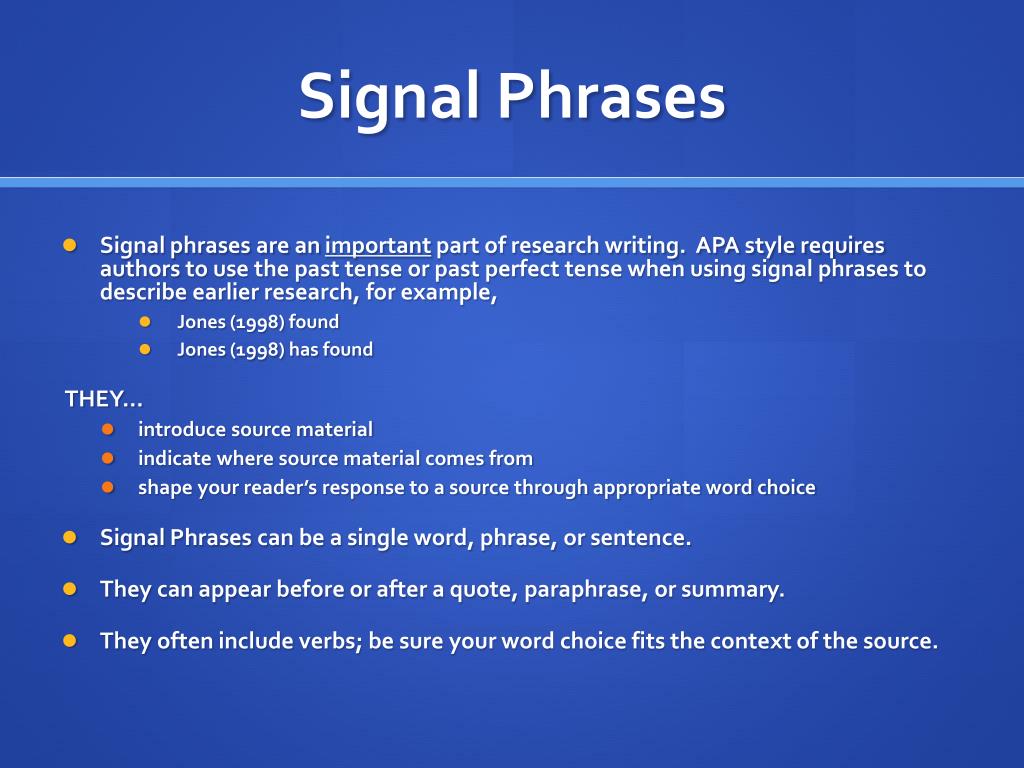


“When I was watching the news, I heard them say that. When you’re discussing a topic in person with one or more people, you will find yourself referencing others’ ideas (outside sources): Consider the metaphor that writing a paper and including sources is a kind of conversation about a topic. Integrating others’ ideas and words materials into your own text can be tricky. Correctly utilizing and synthesizing your sources is much like fitting together the pieces of a puzzle. Save those moments of personal pronoun usage for extremely important moments in your paper (e.g., “In this paper, I argue that …”).Figure 1.

Doing so draws attention to what you’re doing with the text when the focus should be on what the text is doing.
SIGNAL PHRASE EXAMPLES HOW TO
Not to put too fine of a point on it, but I usually use the third-person when giving a “text statement” (e.g., “This essay considers some questions of crime, criminal justice, and criminology in William Shakespeare’s Measure for Measure”) and the first-person when giving a “thesis statement” (e.g., “I argue that Shakespeare’s play shows the abuses of power that can occur when individual law enforcement agents receive both a mandate to crackdown on social disorder and the authority to decide for themselves what counts as disorder and how to fight it”).Īdditionally, when flagging your information, be careful with pronouns: try to remove from a paper the fact that “you’re” leading “us” through an idea. When framing a paper in the introduction, alternate between first-person pronoun usage (“I consider,” “I argue,” “I approach this problem from the perspective of,” etc.) and third-person noun usage (“This essay explores,” “This paper draws from the vocabulary of,” “As this paper demonstrates,” etc.). In this paper, I argue that, even more than Hamlet and his thoughts on ‘the purpose of playing,’ Horatio emerges in Hamlet as an avatar for Shakespeare and a model for the kind of story-teller Shakespeare wanted to be." This passage could more eloquently be edited as follows: "This paper explores the problem of Horatio in Shakespeare's Hamlet. For example, if your first sentence were a text statement and your second sentence were a thesis statement, it would sound goofy to say: "In this paper, I explore the problem of Horatio in Shakespeare's Hamlet, especially the fact that Horatio loves to tell stories. Show, don’t tell, but do try to flag.īe careful not to over-flag your introductory material, which can make your paper sound mechanical. It would be better to say something like (for occasion), “The problem with is that … ,” or (for methodology), “This essay looks at from the perspective of … ,“ or (for assertions and analyses) to give the details specific to your ideas. Likewise, it would be awkward to read, “My occasion for this essay is … ,” or “My methodology is … ,” or “I assert that … ,” or “My analysis of this evidence is that … ”. For example, it would be awkward for a paper to say something like, “My text is … ,” a flag that could be better stated as, “In this paper, I examine … ”.

That is, without being heavy-handed about it, include signal phrases in your writing that alert your reader to the kind of information you are communicating in each part of your paper. When presenting academic information, show, don’t tell, but do try to flag.


 0 kommentar(er)
0 kommentar(er)
